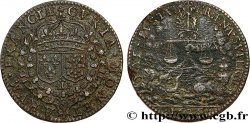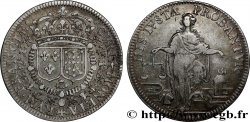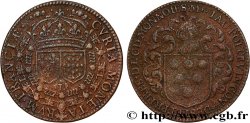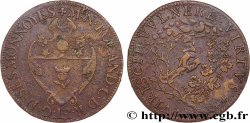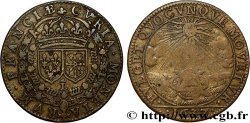fjt_014703 - COUR DES MONNAIES DE PARIS Séraphin de Mauroy - REFRAPPE n.d.
Not available.
Item sold on our e-shop (2015)
Price : 45.00 €
Item sold on our e-shop (2015)
Price : 45.00 €
Type : Séraphin de Mauroy - REFRAPPE
Date: n.d.
Metal : red copper
Diameter : 28 mm
Orientation dies : 6 h.
Edge : cannelée
Rarity : R1
Catalogue references :
Predigree :
Cette refrappe provient de la collection Pierre-Yves Lathoumétie
Obverse
Obverse legend : CVRIA MONETARVM FRANCIAE.
Obverse description : Armes de France-Navarre.
Reverse
Reverse legend : MRE SERAPHIN DE MAVROY CER D R EN SES CELZ INTD ET CONEVR D FIN.
Reverse description : Armes de Séraphin de Mauroy lambrequinées.
Commentary
Séraphin de Mauroy, un intendant du roi, racheta en 1627 les droits seigneuriaux de Saint Ouen. Son successeur, Joachim Seiglières, seigneur de Boisfranc et surintendant des finances de Monsieur, le frère de Louis XV, fit construire en 1670, par l'architecte Antoine Lepautre (1621-1691). Nous n’avons pas trouvé d’explication au lien sur ce jeton entre Mauroy et la Cour des monnaies.
Refrappe certaine bien que le jeton soit sans poinçon. Ce type de refrappe a été fait pour collectionneurs et pour pallier à l’impossibilité de trouver certains jetons, rarissimes voire inconnus en frappe originale. En vingt ans de commerce de jetons nous n’avons jamais pu offrir ce jeton en original. Ce type n’est signalé par Feuardent que comme refrappe.
Séraphin de Mauroy, a king's steward, bought the seigneurial rights of Saint Ouen in 1627. His successor, Joachim Seiglières, lord of Boisfranc and superintendent of finances for Monsieur, the brother of Louis XV, had it built in 1670 by the architect Antoine Lepautre (1621-1691). We have not found an explanation for the link on this token between Mauroy and the Cour des monnaies. Certainly a re-strike, although the token is without a hallmark. This type of re-strike was done for collectors and to compensate for the impossibility of finding certain tokens, extremely rare or even unknown in their original mintage. In twenty years of trading in tokens, we have never been able to offer this token in its original form. This type is only reported by Feuardent as a re-strike
Refrappe certaine bien que le jeton soit sans poinçon. Ce type de refrappe a été fait pour collectionneurs et pour pallier à l’impossibilité de trouver certains jetons, rarissimes voire inconnus en frappe originale. En vingt ans de commerce de jetons nous n’avons jamais pu offrir ce jeton en original. Ce type n’est signalé par Feuardent que comme refrappe.
Séraphin de Mauroy, a king's steward, bought the seigneurial rights of Saint Ouen in 1627. His successor, Joachim Seiglières, lord of Boisfranc and superintendent of finances for Monsieur, the brother of Louis XV, had it built in 1670 by the architect Antoine Lepautre (1621-1691). We have not found an explanation for the link on this token between Mauroy and the Cour des monnaies. Certainly a re-strike, although the token is without a hallmark. This type of re-strike was done for collectors and to compensate for the impossibility of finding certain tokens, extremely rare or even unknown in their original mintage. In twenty years of trading in tokens, we have never been able to offer this token in its original form. This type is only reported by Feuardent as a re-strike








 Report a mistake
Report a mistake Print the page
Print the page Share my selection
Share my selection Ask a question
Ask a question Consign / sell
Consign / sell
 Full data
Full data